- CTO AI Insights
- Posts
- Tech Intensity: Unlocking £4m Revenue Potential for Enterprise Leaders
Tech Intensity: Unlocking £4m Revenue Potential for Enterprise Leaders
Why you need to be service-aware and have tech intensity to succeed

You’re Losing £4m in Revenue Because You Have No Tech Intensity
Why are your competitors launching services in weeks whilst you take months? You are not service aware. You do things technology aware, but forget about your Why.
To be service aware is to have tech intensity in your enterprise and therefore a money maker.
Below is a continuation from yesterday’s article:
I specifically round up yesterday’s article with our new CSDM AI Expert.
The Question Your Board Will Ask Next Quarter
At your next board meeting or senior leadership forum, try this experiment:
Ask which of your 2,000 applications support your five most critical business capabilities. Watch the room go silent. That silence represents a £4 million revenue gap between your organisation and digital leaders—and the gap widens daily.
MIT CISR's research proves it quantitatively: companies with what Jeanne Ross calls "operational backbones"—architectural discipline to understand how technology delivers value—generate £4 million more revenue per employee than those without.
But here's what keeps digital leaders awake at night: knowing that every week they delay architectural transformation, competitors pull further ahead. Not incrementally. Exponentially. And when boards recognise this gap, they don't typically invest in transformation. They replace the technology leadership. and then never achieve any intensity of the products they pay for.
This isn't about having more technology. Every enterprise has plenty of that. This is about Technology Intensity—the recognition that your applications aren't overhead to be managed; they're intellectual property to be leveraged. And the difference between these two perspectives? It's architectural.
Act I: The Crisis You're Already Living
Three Symptoms You'll Recognise Immediately
The Strategic Paralysis
When your CEO asks how long to launch a new customer service, you say six months. Your competitor launched theirs in three weeks. That's not a skills gap or a budget gap. That's an architecture gap—and it's costing you market position daily.
Try answering these questions in your next executive meeting:
Which applications support customer relationship management capability?
If we acquire a competitor, which of our applications overlap with theirs?
A zero-day vulnerability just emerged—what's our exposure across the enterprise?
If your answer to any of these is "I'll get back to you in a few weeks," you're operating without what I call Technology Intensity. Your competitors are answering these questions in minutes, making strategic decisions whilst you're still gathering data.
The Reusability Desert
Here's a calculation that should concern every technology leader: If building authentication takes six weeks, and you have twenty applications that need it, you've spent 120 weeks of engineering time solving the same problem twenty times.
That's not building intellectual property. That's burning it.
When Maersk rebuilt their platform using component architecture, they discovered that 73% of their new initiatives were rebuilt capabilities that already existed elsewhere in the organisation. The cost? Over £42 million in duplicated engineering effort annually. (Source: Maersk Digital Transformation case study, 2023)
The Innovation Tax
You've invested millions in digital technology, yet launching a simple new service requires six months of integration work. More technology has delivered less flexibility. Your best engineers spend 60% of their time solving solved problems instead of creating new capabilities.
ING Bank faced exactly this challenge in 2015. Despite significant technology investment, their time-to-market for new products was 18 months—whilst fintech competitors launched in 6-8 weeks. The problem wasn't talent or budget. It was architecture. (Source: ING Agile Transformation, Harvard Business Review, 2017)
Act II: Why This Happens—The Intellectual Property You Can't See
From Overhead Thinking to Asset Thinking
Most enterprises treat technology as overhead—systems to maintain, costs to minimise, efficiency to improve. This mindset is visible in every budget conversation: "How can we reduce IT spending?" rather than "How can we increase our technology leverage?"
But digital leaders think differently. They recognise that in 2025, software capabilities are intellectual property—regardless of whether you sell software or cars or insurance. Your unique combination of digital components, your architectural patterns, your ability to rapidly compose new offerings—this is your competitive moat.
Consider Amazon. Their retail platform appeared to be overhead—systems for managing inventory, processing orders, handling payments. But Jeff Bezos recognised these were reusable components that could become AWS, a business now generating over £60 billion annually.
That's Technology Intensity: seeing applications as assets to leverage, not costs to contain.
The question for your board isn't "Do we have 2,000 applications?" It's "Do we have a digital platform with 2,000 components we can compose into competitive advantage?"
The Architecture Debt You're Paying Daily
One of my favourite problems to solve is “spaghetti and meatball” architecture—point-to-point integrations, duplicated capabilities, zero reusability—is the visible symptom of low Technology Intensity. I am an enterprise architect by trade, and this is my breakfast.
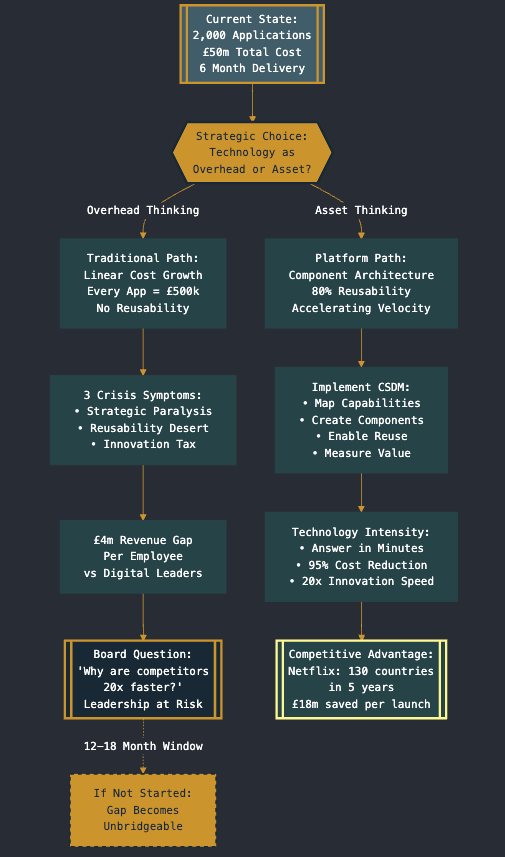
The mathematics are brutal:
Traditional IT Economics: Linear cost growth
Application 1 costs £500K to build
Application 2 costs £500K to build
Application 100 costs... £500K to build
Total: £50 million with no economies of scale
Platform Economics: Sublinear cost growth, superlinear value growth
Component 1 costs £600K to build (higher initial investment for reusability)
Application 2 reuses Component 1, costs £200K
Application 3 reuses Components 1 and 2, costs £150K
Application 100 might cost £50K—just composition and configuration
Total: £15 million, with accelerating velocity
The difference isn't marginal. It's exponential. And it compounds with every initiative.
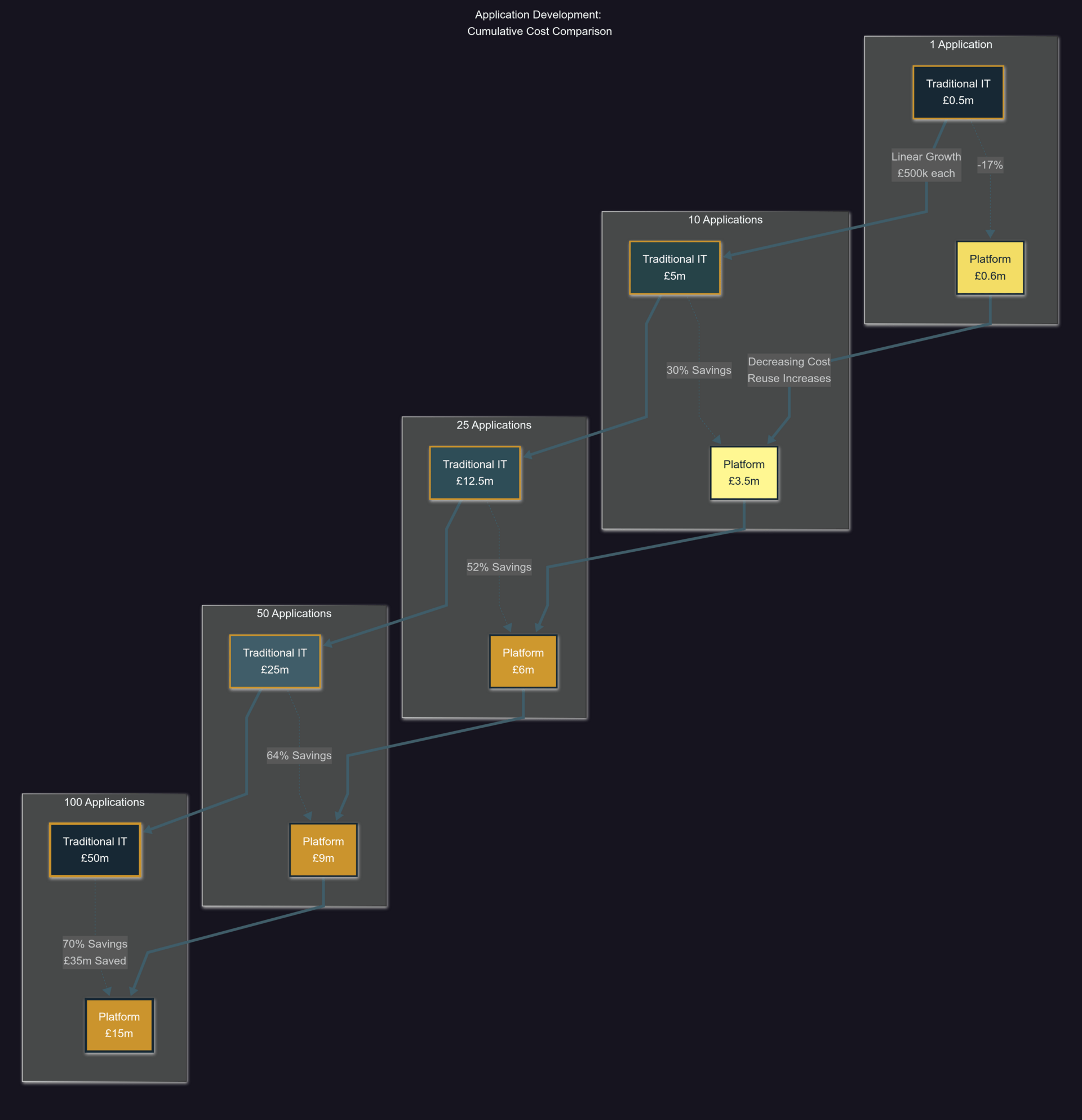
Enterprise Technology: Rooms In A Building You Rent But Never Use
The SaaS products you buy through license (SAP, ServiceNow, Dynatrace, Workday etc) render some services for your organisation. You do not own them, you rent them (licensed subscription).
To access the rooms of your SaaS products require not only you pay a license per user, but that you also do the minimum requirements to qualify the enablement of the room’s features. Data is the most common minimum requirement.
In the case of a Service Model (like the CSDM) it activates so many features of your SaaS landscape. It unleashes significant Tech Intensity. If you do not implement these types of minimum requirements, you continue to pay for the room in the building, but you do not get to use it.
You are then, not service aware.
What CSDM Has to Do With Intellectual Property
Here's where a enterprises Common Service Data Model (CSDM) transforms from technical framework to strategic enabler. Think of CSDM as your digital intellectual property portfolio management system—the architecture that transforms those 2,000 applications from managed overhead into leverageable assets.
But most organisations implement CSDM as inventory management—tracking what exists. That's necessary but insufficient. Technology Intensity requires understanding:
What capability each application delivers (Business Capability mapping)
How applications compose into larger services (dependency architecture)
Which components can be reused (service catalogue)
What technical debt you're carrying (technology risk)
How to measure strategic value (business impact assessment)
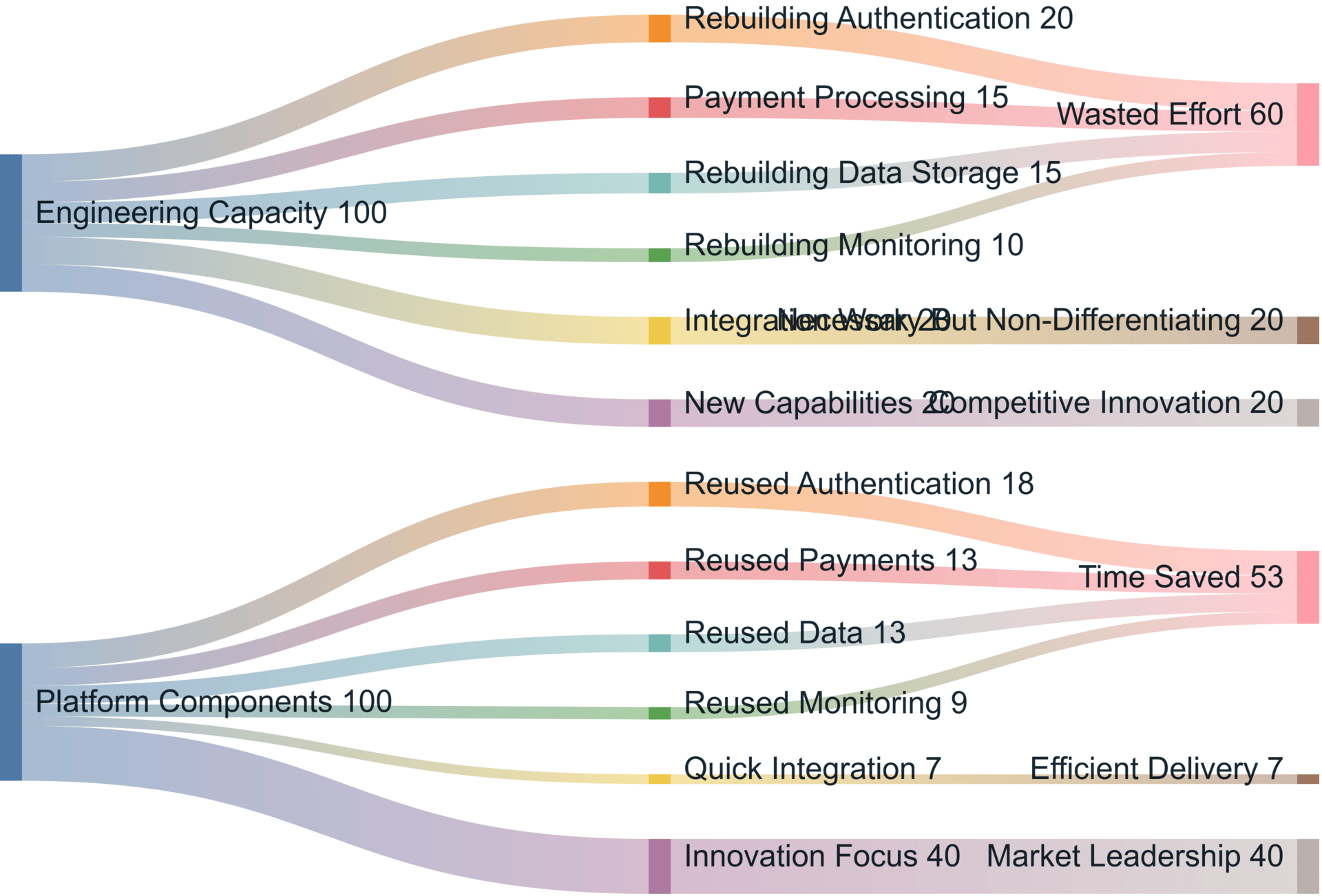
When Spotify rebuilt their platform architecture in 2016, they started by mapping their 200+ services to core business capabilities. This revealed that 40% of their engineering effort went to capabilities that delivered no competitive differentiation—authentication, data storage, logging, monitoring. By consolidating these into reusable platform components, they freed 40% of engineering capacity for competitive innovation. (Source: Spotify Engineering Culture, 2016)
That's the CSDM principle in practice: understand what you have as components, not just applications. Map those components to business value.
Enable reuse.
Compound your advantage.
Act III: The Platform Economics That Change Everything
The Component Reusability Multiplier
Here's the economic inversion that defines Technology Intensity: initial investment increases, but marginal cost collapses.
Netflix provides the clearest example. In their early years, every new market expansion required 6-9 months of custom development—payment processing, content delivery, recommendation engines, user management. Each country launch cost £15-20 million.
Then they embraced component architecture. By 2018, launching in a new country took 4-6 weeks and cost under £2 million—95% of capabilities were reused components, 5% was localisation. They launched in 130 countries in five years, an impossible feat with their original architecture. (Source: Netflix Tech Blog, 2019)
The mathematics of reusability:
0% Reusability (current state for most): Every project rebuilds common capabilities
50% Reusability (achievable within 12 months): Half of new projects compose from existing components
80% Reusability (digital leaders): Only novel capabilities require new development
Forrester's 2024 research into platform leaders found development productivity improvements of 35-40% were standard—not because developers coded faster, but because they assembled proven components rather than rebuilding from scratch. (Source: Forrester Total Economic Impact of Enterprise Architecture Modernisation, 2024)
Strategic Decisions at Digital Speed
Technology Intensity transforms how quickly you can answer strategic questions. With proper CSDM implementation, you move from archaeological expeditions to instant analysis.
The Acquisition Question
When Microsoft acquired LinkedIn for £21 billion, one critical question was technology overlap. With mature architectural visibility, they identified integration points and redundant systems within 48 hours of deal announcement. Traditional enterprises spend 6-12 months post-acquisition discovering what they've bought. (Source: Microsoft-LinkedIn Integration case study, 2018)
Your board asks: "We're considering acquiring Company X. Which applications overlap?"
Without Technology Intensity: Six months of manual surveying, spreadsheet comparison, incomplete analysis
With Technology Intensity: Two hours—query Business Applications by Business Capability, compare, identify redundancies, estimate integration costs
The Vulnerability Question
When the Log4j vulnerability emerged in December 2021, enterprises fell into two categories:
Low Technology Intensity: Weeks spent surveying teams, checking applications, hoping they found everything. Capital One took 19 days to confirm full remediation. (Source: Capital One Security Response Timeline, Wall Street Journal, 2022)
High Technology Intensity: Query the Software Bill of Materials (SBOM), identify affected applications in 90 minutes, prioritise by business criticality, deploy patches in priority order. Shopify confirmed and patched all exposure within 6 hours. (Source: Shopify Engineering Blog, 2021)
The difference? Architectural discipline through CSDM. Organisations with mature SBOM implementation weren't lucky—they were prepared.
The Technical Debt Question
Your CFO asks: "How much technical debt are we carrying, and what's it costing us?"
Without proper architecture, the answer is vague: "Lots. Everywhere. Too much."
With Technology Intensity via ServiceNow's Technology Portfolio Management (fully dependent on CSDM), you answer precisely:
Location: 47 business-critical applications run on Windows Server 2012 (end-of-life)
Business Impact: They support 12 core capabilities serving 50,000 customers
Financial Impact: £2.3M annual maintenance cost vs £4.1M one-time modernisation
Risk Profile: High—security vulnerabilities with no patches, compliance exposure
Remediation Roadmap: Prioritised by business criticality and technical complexity
This is Technology Intensity in action: treating technical debt not as abstract concept, but as measurable technical liability in your intellectual property portfolio.
Act IV: The Urgency—Why the Window Is Closing Fast
The AI Multiplication Factor
Every organisation is deploying AI. Chatbots. Predictive models. Process automation. GenAI capabilities. But without architectural discipline, AI becomes another point solution—disconnected from business processes, unable to access enterprise data, duplicate capabilities across departments, no governance.
The result: shadow AI—the 2025 equivalent of shadow IT.
Here's why Technology Intensity matters more in the AI era: AI amplifies existing advantages.
If digital leaders are already 10× faster at innovation due to platform architecture, and AI makes them 2× faster still, they're now 20× ahead. Meanwhile, organisations struggling to deploy AI at all because they lack architectural foundations find the gap isn't widening—it's exploding.
As an example, ServiceNow's AI Control Tower—designed to govern AI assets across the enterprise—depends entirely on CSDM to understand which AI models support which business services. Without that context, you can't assess AI business criticality, can't prioritise AI governance, can't measure AI ROI.
Organisations that built operational backbones over the past decade are positioned to dominate the AI era. Those that didn't are scrambling to deploy AI on unstable foundations—and discovering it's nearly impossible.
The Competitive Timeline
MIT CISR's longitudinal research of 1,200 enterprises reveals a brutal timeline: organisations that don't establish architectural discipline over their services within 12-18 months find the gap unbridgeable—not technically, but economically. First movers in platform architecture achieve compounding advantages competitors can't overcome. (Source: MIT CISR Digital Maturity Research, 2024)
The organisations hesitating today won't just be 12 months behind next year. They'll be competing using 2010 architecture against rivals operating with platform economics. The outcome of that competition is predetermined.
The Personal Stakes
Here's what's rarely discussed openly: when boards recognise the architecture gap, they don't typically invest in transformation first. They replace the technology leadership. Your ability to answer strategic questions in real-time, demonstrate technology as asset rather than cost, and accelerate innovation velocity—these aren't just operational metrics. They're career-defining capabilities.
Your engineering team are world-class. They solve impossible problems daily. But you're asking them to solve the same problems repeatedly whilst competitors build on stable foundations. That's not a people problem—that's a leadership architecture decision. And your best engineers know it.
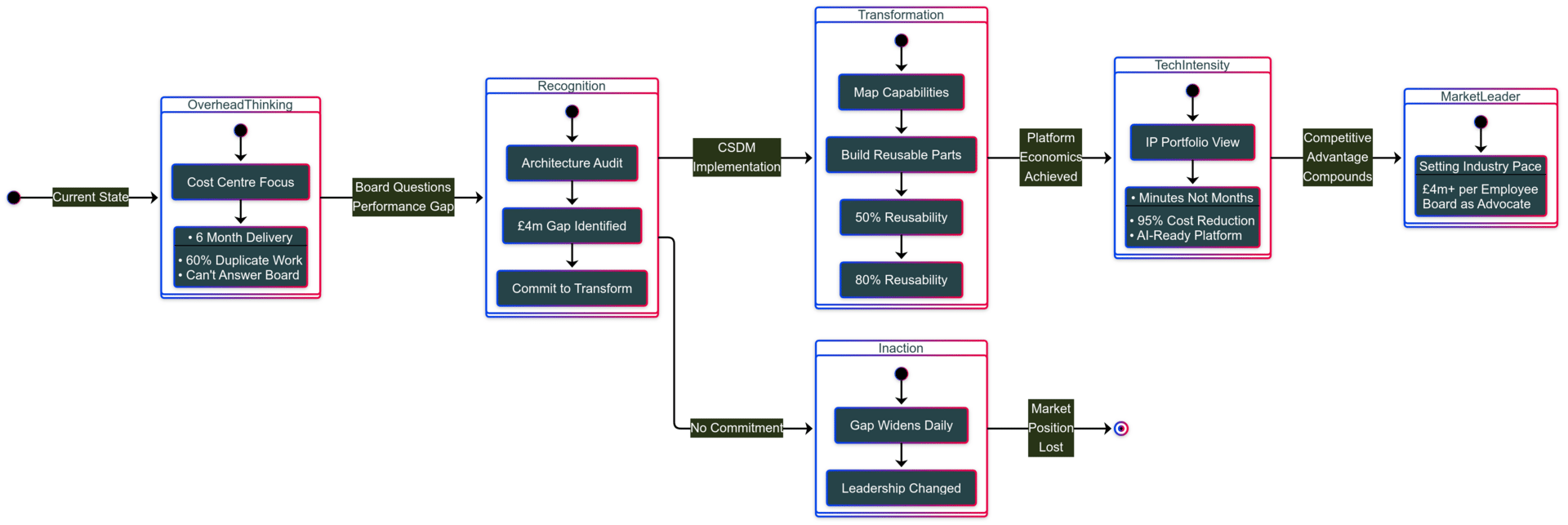
When you can answer the board's strategic questions in real-time instead of promising a report in two weeks, you shift from order-taker to strategic advisor. That transformation begins with architectural discipline.
Act V: The Action—What You Do This Week
The 3-Question Architecture Audit
Before your next board meeting, answer these three questions precisely. If you can't, you lack Technology Intensity:
Question 1: The Strategic Question
Which of your applications support your five most critical business capabilities?
Not which applications exist—which capabilities they support. Can you trace from "customer acquisition" capability down through applications to deployed services to infrastructure? If this requires weeks of analysis, you're operating blind.
Question 2: The Security Question
A zero-day vulnerability emerged this morning in a component your applications use. How long to identify every affected system and prioritise remediation?
If your answer is "weeks" rather than "minutes," you don't have a Technology Intensity problem—you have a survival problem.
Question 3: The Innovation Question
How long to launch a new customer-facing service that requires authentication, payment processing, customer data, and notifications?
If your answer is measured in quarters rather than weeks, your architecture is the constraint on competitive velocity.
The Board Conversation Framework
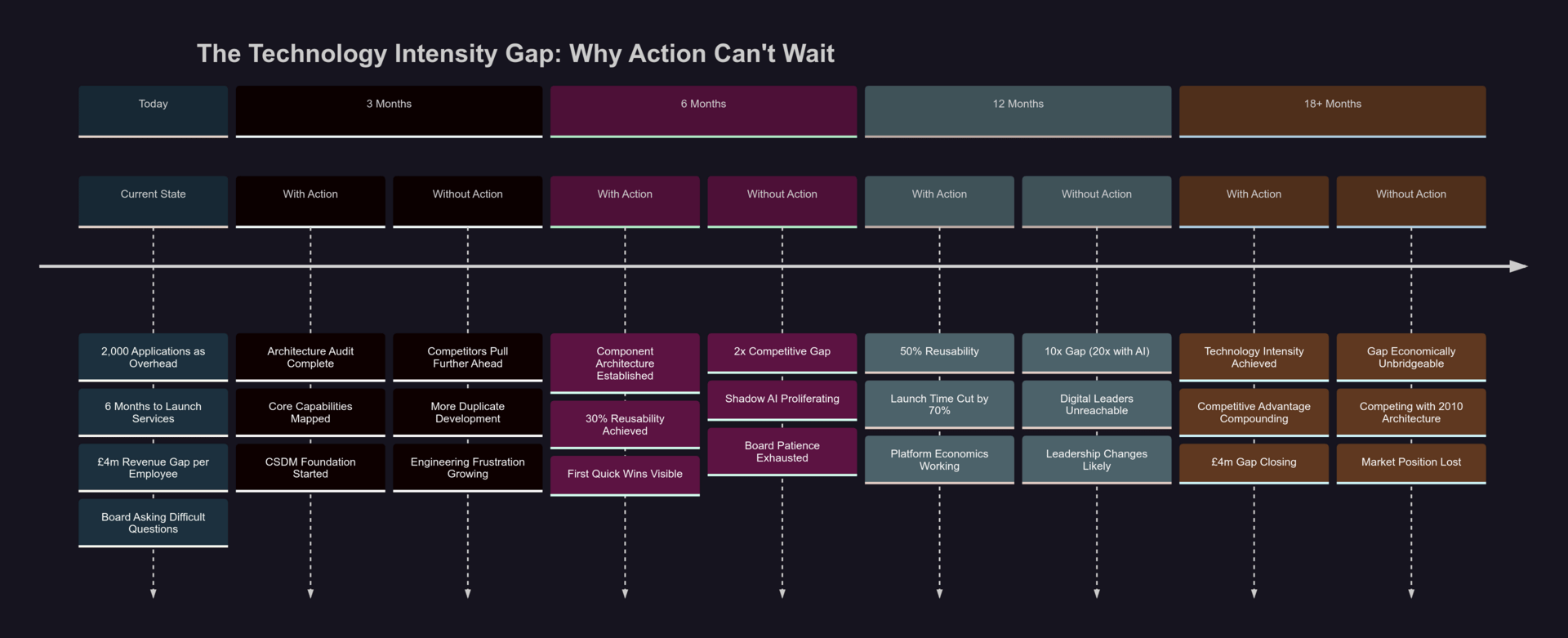
Can't answer these questions? Your next step isn't a CSDM implementation project—it's a strategic conversation with your board about whether technology is overhead or intellectual property in your organisation.
The Framing: "We face an architectural choice that determines competitive position. Current state: 2,000 applications managed as overhead. Target state: digital platform with 2,000 components as intellectual property. The gap costs us £4 million per employee in revenue versus digital leaders. The window to transform is 12-18 months."
The Ask: "We need commitment to architectural discipline—not just technology investment, but governance, ownership, and measurement of Technology Intensity. This is business transformation enabled by architecture, not an IT initiative."
The Timeline: "90 days to assess current state and define core capabilities. 6 months to establish component architecture for critical services. 12 months to achieve 50% reusability and demonstrate competitive velocity."
Starting This Week
Monday: Schedule the architecture audit. Attempt to answer the three questions above. Document gaps.
Tuesday: Identify your 10 most critical business capabilities. Which applications support them? Who knows?
Wednesday: Calculate your reusability percentage. How much engineering effort goes to rebuilding existing capabilities?
Thursday: Map one critical business capability end-to-end—from business outcome through applications to infrastructure. How long does this take?
Friday: Present findings to your executive team. Frame as "Technology as overhead vs intellectual property" choice.
Next Week: If you can't answer the strategic questions, you need the framework to transform. The CSDM provides that framework. But you need the commitment to implement it properly whilst you still have time.
The Choice: Architecture as Strategy
Enterprise architecture is strategy.
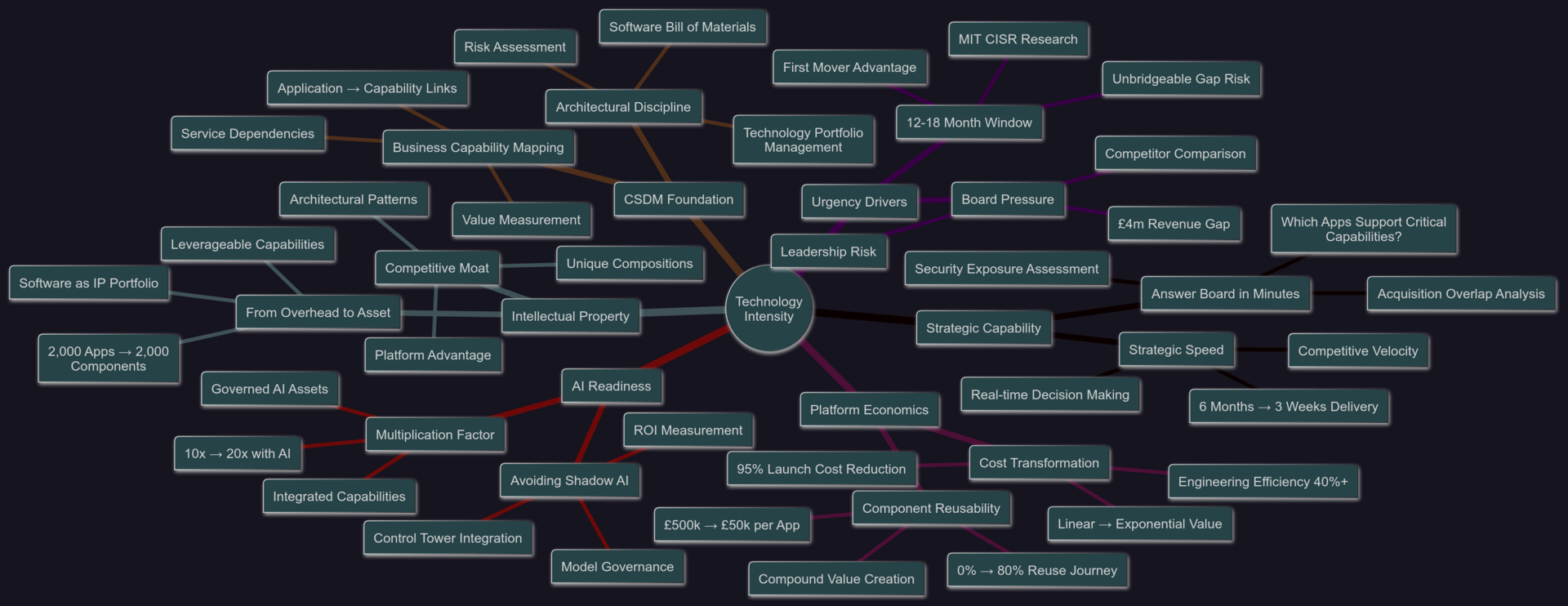
Your digital platform architecture isn't infrastructure—it's how you compete. It is how you leverage your services for your gain. Be service aware. Be tech intense.
ServiceNow's CSDM provides the framework to implement this strategy. But the framework alone isn't sufficient. You need the commitment to Technology Intensity—the recognition that applications are intellectual property to be leveraged, not overhead to be minimised.
The organisations that embrace this principle, implement the architecture properly, and sustain the discipline through governance will create defensible competitive advantages that compound over years.
Those that don't will find themselves competing using 2010 architecture against rivals operating with platform economics in 2025.
Your ServiceNow investment—the CSDM implementation you've been deferring—isn't a data modelling exercise. It's the architectural foundation for Technology Intensity. It's how you transform technology from cost centre to strategic asset.
The question isn't whether Technology Intensity matters. MIT CISR's data proves it does—to the tune of £4 million per employee. The question is whether your organisation will commit to the architectural discipline required to achieve it.
Schedule the architecture audit this week. Because your competitors already have.
About Technology Intensity
Technology Intensity is the principle that market leadership comes from treating technology as proprietary intellectual property. Research from MIT CISR, Forrester, and Gartner consistently demonstrates that organisations with architectural discipline—what Jeanne Ross calls "operational backbones"—outperform peers by £4 million in revenue per employee. ServiceNow's CSDM v5 provides the practical framework to achieve Technology Intensity at enterprise scale.
Reply